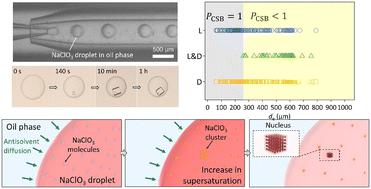Our official English website, www.x-mol.net, welcomes your
feedback! (Note: you will need to create a separate account there.)
Microfluidic antisolvent crystallization for chiral symmetry breaking
Lab on a Chip ( IF 6.1 ) Pub Date : 2024-09-30 , DOI: 10.1039/d4lc00658e Jiye Jang, Gerard Coquerel, Tae Seok Seo, Woo-Sik Kim, Bum Jun Park
Lab on a Chip ( IF 6.1 ) Pub Date : 2024-09-30 , DOI: 10.1039/d4lc00658e Jiye Jang, Gerard Coquerel, Tae Seok Seo, Woo-Sik Kim, Bum Jun Park

|
We report on the use of a microfluidic antisolvent crystallization method to investigate the effect of solution volume on the chiral symmetry breaking (CSB) phenomena of enantiomeric sodium chlorate crystals. The utilization of a microfluidic device is capable of periodically producing emulsion droplets of uniform size and facilitates the quantitative analysis and visualization of crystallization phenomena occurring within the individual emulsions immersed in an oil continuous medium (i.e., dodecane). To promote nucleation and crystallization, a small amount of an antisolvent (i.e., ethanol) is introduced into the continuous phase. We observe that 100% CSB occurs within a certain critical emulsion volume. Beyond this critical volume, the probability of forming two different enantiomeric crystal particles increases. This solution volume-dependent CSB phenomenon can be attributed to the rapid depletion of surrounding molecules by spontaneous crystal growth after the formation of the initial nucleus within the critical volume, thereby suppressing further primary nucleation.
中文翻译:

用于打破手性对称性的微流体反溶剂结晶
我们报道了使用微流体反溶剂结晶方法研究溶液体积对对映体氯酸钠晶体手性对称破坏 (CSB) 现象的影响。利用微流体装置能够周期性地产生大小均匀的乳化液滴,并有助于定量分析和可视化浸入油连续介质(即十二烷)中的单个乳化液中发生的结晶现象。为了促进成核和结晶,将少量反溶剂(即乙醇)引入连续相中。我们观察到 100% CSB 发生在一定的临界乳化体积内。超过这个临界体积,形成两种不同对映体晶体颗粒的可能性增加。这种溶液体积依赖性 CSB 现象可归因于在临界体积内形成初始原子核后自发晶体生长对周围分子的快速消耗,从而抑制了进一步的初级成核。
更新日期:2024-10-05
中文翻译:

用于打破手性对称性的微流体反溶剂结晶
我们报道了使用微流体反溶剂结晶方法研究溶液体积对对映体氯酸钠晶体手性对称破坏 (CSB) 现象的影响。利用微流体装置能够周期性地产生大小均匀的乳化液滴,并有助于定量分析和可视化浸入油连续介质(即十二烷)中的单个乳化液中发生的结晶现象。为了促进成核和结晶,将少量反溶剂(即乙醇)引入连续相中。我们观察到 100% CSB 发生在一定的临界乳化体积内。超过这个临界体积,形成两种不同对映体晶体颗粒的可能性增加。这种溶液体积依赖性 CSB 现象可归因于在临界体积内形成初始原子核后自发晶体生长对周围分子的快速消耗,从而抑制了进一步的初级成核。

































 京公网安备 11010802027423号
京公网安备 11010802027423号